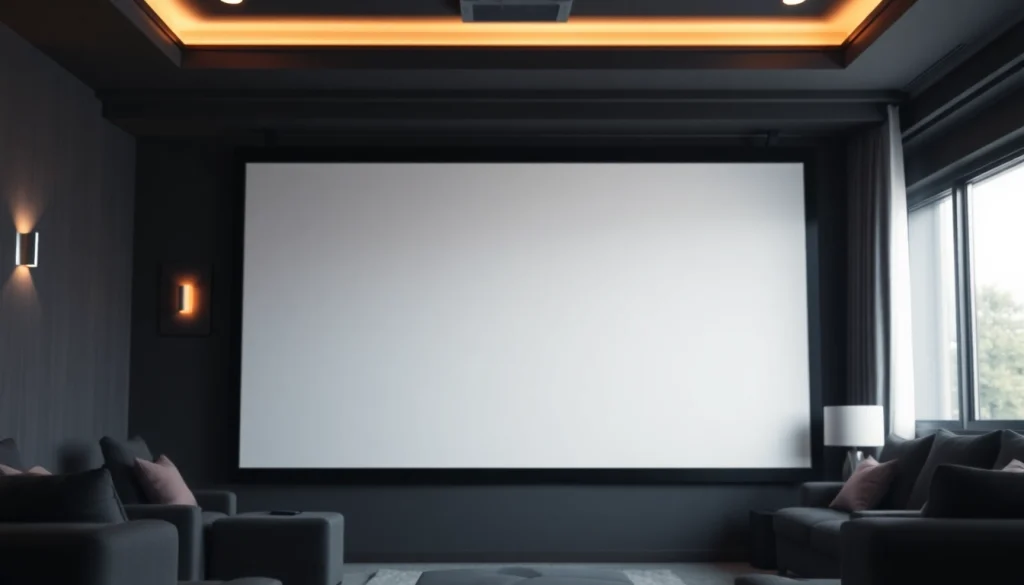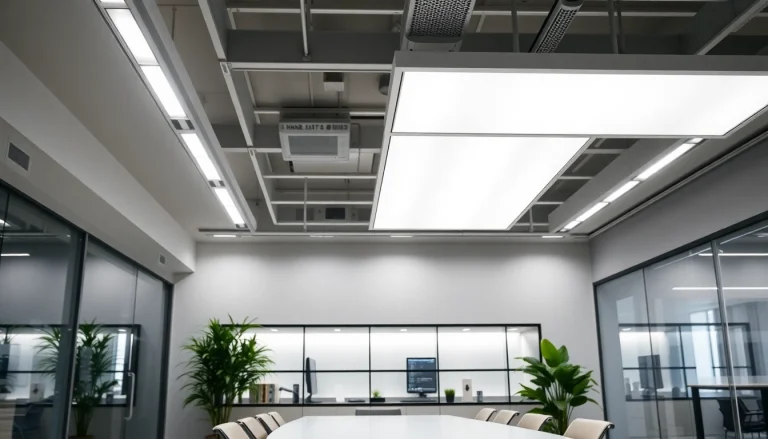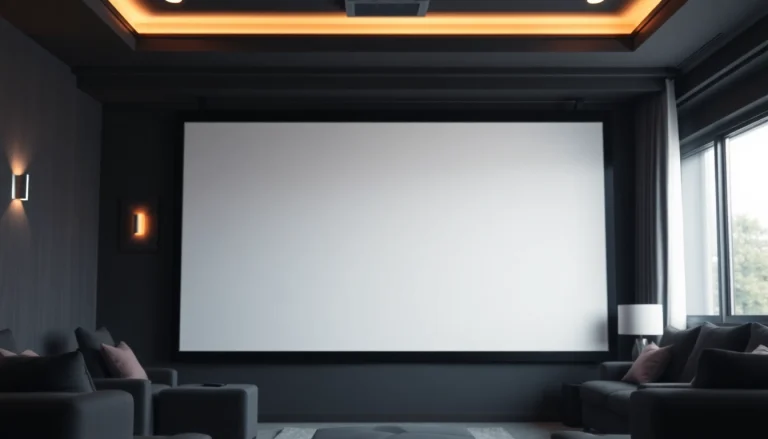
Understanding Fixed Frame Projector Screens
What is a Fixed Frame Projector Screen?
A fixed frame projector screen is a type of projection screen that is mounted permanently to a wall, making it ideal for home theaters, offices, classrooms, and various venues where consistent and high-quality visual displays are essential. Unlike retractable or portable screens, fixed frames do not move or fold, meaning they maintain a perfectly taut surface that resists wrinkles and distortion. This stability enhances the overall viewing experience, ensuring that images projected onto the screen offer vibrant colors and clear detail. Typically, these screens feature a sturdy frame covered in a velveteen material that not only provides a refined appearance but also helps absorb excess light, enhancing contrast during projections.
Benefits of Using a Fixed Frame Projector Screen
Opting for a fixed frame projector screen comes with numerous advantages. Firstly, these screens provide superior image quality, as the tensioned surface minimizes imperfections that might disrupt a coherent viewing experience. The gain factor, a measure of the screen’s reflectivity, can be more consistently controlled as the surface remains stretched, giving you a reliable display for watching movies or giving presentations.
Another significant benefit is the aesthetic appeal. A fixed frame projector screen can serve as an elegant focal point in a room, transforming your space into a stylish and functional home theater or conference area. Additionally, they often come with a variety of available finishes and frame designs, allowing for customization based on personal taste and existing decor.
Furthermore, the absence of mechanical parts in fixed screens means fewer maintenance issues. Users can expect consistent performance without the worries of motorized malfunctions that can plague retractable screens.
Types of Materials Used in Fixed Frame Screens
The materials used in fixed frame projector screens play a crucial role in their overall performance. Most commonly, screens are made from the following materials:
- White Fabric: This standard material offers good color accuracy and brightness. It is suitable for a wide range of projectors and ambient light conditions.
- Grey Material: Often utilized for high-contrast images, grey screens effectively enhance black levels and improve contrast in brighter environments.
- Specialty Materials: These include materials enhanced for 4K and 8K resolution, as well as ambient light-rejecting (ALR) screens designed for bright rooms. These materials can significantly improve the perceived performance of a projector, ensuring that images remain crisp and vibrant regardless of the viewing conditions.
Choosing the Best Fixed Frame Projector Screen
Key Features to Consider
When searching for the Best Fixed Frame Projector Screen, various key features come into play:
- Gain: This refers to how much light the screen reflects towards the viewer. A common gain range is between 1.0 and 1.3, but depending on your projector and room lighting, you might choose differently.
- Resolution Capability: Ensure the screen material is compatible with your projector’s resolution. High-definition projectors will benefit from screens designed for 4K or 8K displays.
- Size and Aspect Ratio: Consider your room’s dimensions and the typical viewing distance. Screens come in various sizes and aspect ratios like 16:9 for standard HD content or 2:35:1 for a cinematic experience.
- Frame Type: Look for a sturdy frame that complements your aesthetic needs while remaining durable. Options may vary from sleek, minimalist designs to more traditional or ornate frames.
Determining the Right Size
Choosing the right size for your fixed frame projector screen is integral to achieving an immersive viewing experience. A general guideline is to measure the distance from your seating area to the screen and consider the diagonal size of the screen relative to that distance. A recommended range is that the screen should occupy about one-third of the viewer’s field of vision for optimal enjoyment. Thus, if you sit 10 feet away from the screen, a 100 to 120-inch diagonal screen would be ideal.
Moreover, the layout of your room and the mounting height should also be factored in. The bottom of the screen should be at eye level when seated, allowing for the most comfortable viewing angle. Adjusting for these factors ensures you maximize the fixed frame screen’s potential.
How to Select the Best Gain for Your Room
Screen gain is pivotal in determining how bright an image appears on the projector screen. When selecting the best gain factor for your room, consider these aspects:
- Room Brightness: If your viewing environment can be dimmed effectively, a standard gain of 1.0 is typically ideal. However, if you’re dealing with ambient light or have a brighter environment, you may want to consider a screen with a higher gain.
- Projector Brightness: The lumen output of your projector also plays a role. Higher-output projectors may benefit from lower gain screens, while those with lower output may require screens with higher gain to enhance brightness levels.
- Viewing Angle: Higher gain screens often have more focused viewing angles, meaning that while the brightness increases, colors may distort when viewed from the sides. Ensure to balance gain with the potential viewer layout in your space.
Installation Tips for Fixed Frame Projector Screens
Preparing Your Space for Installation
Before the installation of your fixed frame projector screen, take time to prepare your space effectively. Begin by determining the ideal location based on size, viewing angle, and proximity to power outlets for your projector. It’s crucial to consider the screen’s height for optimal viewing comfort.
Additionally, assess the wall’s surface where installation will take place; it should be sturdy enough to support the frame. If necessary, reinforce the wall or utilize mounting brackets designed for heavier screens to ensure everything is secure.
Step-by-Step Installation Guide
Here’s a simplified guide to successfully install your fixed frame projector screen:
- Gather Tools: You will need a drill, level, measuring tape, screws, and possibly a stud finder.
- Measure: Use your measuring tape to mark where the frame will be mounted on the wall, accounting for the height, width, and levelness.
- Mount the Frame: Drill holes at the marked points and secure the screen’s frame mounts to the wall, ensuring everything is level before tightening.
- Attach the Screen: If the screen is detachable, carefully attach it to the frame following the manufacturer’s guidelines to avoid stretching or damaging the material.
- Test: Once installed, run a test projection to ensure everything aligns perfectly and make necessary adjustments accordingly.
Common Installation Mistakes to Avoid
Throughout the installation process, several common pitfalls can hinder performance:
- Improper Measurement: Double-check measurements to avoid cutting or mounting mistakes that can affect the screen’s appearance and functionality.
- Neglecting Stability: Ensure that the wall properly supports the screen; poorly installed screens can lead to sagging or detachment during use.
- Ignoring Viewing Angles: Failing to align the screen with the viewer’s line of sight can make for an uncomfortable experience during prolonged use.
Maintenance and Care for Your Fixed Frame Projector Screen
Regular Cleaning Techniques
Proper maintenance of your fixed frame projector screen can significantly extend its lifespan and ensure optimal performance:
Use a soft, dry microfiber cloth for regular dusting, gently wiping the surface without scratching it. For more comprehensive cleaning, engage a slightly dampcloth with water and a mild soap solution. Test in a small corner first to ensure compatibility with the screen material. Avoid using abrasive materials or harsh chemicals, as they can damage the surface significantly.
How to Protect the Screen from Damage
Protection of your screen from physical contact is paramount. Avoid placing objects near the screen that may fall on it or leave marks. Limit exposure to direct sunlight, which can cause fading over time, by adjusting shades or using ambient light-rejecting screens suitable for brighter environments. Furthermore, if your setup allows it, consider incorporating a cover that can be suspended when the screen is not in use to further protect it.
Signs It’s Time for a Replacement
Even with diligent care, eventual replacement of your screen may be necessary. Signs to monitor include:
- Visible Damage: Scratches, tears, or punctures in the screen material that disrupt brightness or detail directly indicate it’s time for a new screen.
- Color Inconsistency: If you notice fading colors or dull images during projection, it is a sign that the material has deteriorated.
- Environmental Effects: Alterations in humidity or temperature could warp the frame and material, leading to further performance issues which cannot be corrected by simple cleaning.
Comparing Top Models of Fixed Frame Projector Screens
Reviewing Popular Brands
In the search for the best fixed frame projector screen, it’s crucial to evaluate various brands based on consumer feedback and performance metrics. Good indicators include quality of materials, customer service reputation, and product longevity. Look for detailed reviews, which may guide you in making an informed decision independent of manufacturer hype.
Price Ranges and Budget Considerations
The price of fixed frame projector screens varies commonly based on size, material, and gain factor. Budget options may start around a few hundred dollars, whereas high-end models for professional or home theater use can exceed a thousand dollars. Consider your budget while factoring in expected usage frequency, as investing in a quality screen can enhance overall visual experiences significantly.
User Feedback and Performance Reviews
To understand how various models perform in real-world settings, consult user reviews across forums and review sites. Focusing on comprehensive performance feedback can illuminate both the strengths and weaknesses of different screens, helping ensure that your choice meets requirements for your unique setup. Look for consistent themes in reviews regarding installation ease, image quality, and durability to fully grasp which options deliver the best value for your investment.






